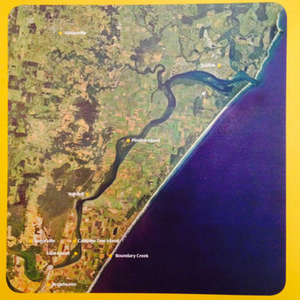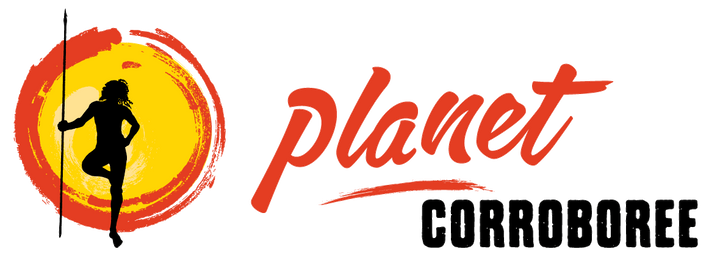Cabbage Tree Island
September 28, 2016
2 Comments

Living in this beautiful part of the Northern Rivers its fascinating to find out more about the local Indigenous mob and what life was like for them in the early 1900’s. I was thinking about Cabbage Tree Island today and decided to find out more about it. I have been there before when my teenage boys were just little toddlers. They are related very closely to the families that have lived there for generations and i was warmed inside to read today that the community was settled by the people themselves and for a long time it was a successful self sufficient community.
Even in the life of Planet Corroboree we had there beautiful handprinted fabrics and handmade clothes the women made for sale as well as paintings from the men and women creating works of art with vibrant colours and unique Bundjalung themes. One of our local legend artists Digby Moran grew up at Cabbage Tree Island and still participates in engaging the mob with the arts.
Below this information is a link to a beautiful book featuring 12 amazing local women who grew up at Cabbage Tree Island, near Wardell, just south of Ballina. It is well worth a read of them sharing their stories.
Boundary Creek is between Wardell and Broadwater. Its one of those special places that as soon as you enter you feel it deep inside that this is place of abundance and wonder.
Here is some info that i found on Cabbage Tree Island today.
Becci
CABBAGE TREE ISLAND INDIGENOUS COMMUNITY
According to Bundjalung oral tradition, during the 1890s a group of Aboriginal people in north-eastern New South Wales (NSW) walked from Wyrallah near Lismore and crossed to Cabbage Tree Island. They aimed to take possession of the land and clear the thick scrub to begin cane farming.
They quickly became self-sufficient. Kitchen gardens provided fresh vegetables; orchards and banana plantations provided fresh fruit and the rearing of cattle provided fresh meat and milk. The establishment of cane farms on the island gave the community a sense of independence.
The rivers, and the estuarine, wetland and sand dune environments on and around Cabbage Tree Island provided an abundance of wild food. There were always plenty of resources to share among the community:
‘… In those days, it was nothing, you know, to go out there [and] get pipis and bring them home. There was plenty to eat … when they’d go, the men used to go up the creeks and early in the morning in the boat, and come back with all these wild foods … they’d have koala, kangaroo, water lily bulbs and swans’ eggs and ducks’ eggs … but everything was shared, that was the beauty of everything.’ Aunty Yvonne Del-Signore, interview 26 January 2005, Boundary Creek
The NSW Aborigines Protection Board was established in the late 1800s. The Board gazetted many areas across NSW as reserves, and in some cases forced Aboriginal families to move onto them.
In 1893, the Board gazetted Cabbage Tree Island as an Aboriginal reserve and families from surrounding areas began to move onto the island. Initially, the community could maintain a self-sufficient way of life, but in 1911 the reserve was redesignated as an Aboriginal station. This meant a white manager lived on the island and controlled the community and farmland.
‘The people on the island years ago, they were self-sufficient you know, they had their own cattle, own orchards, they’d their own cane farms, used to grow bananas and whatever. Beans and peas and things, I mean, they didn’t want [for food] then, until the manager came in and then the manager brought his own cattle there, he had about fifty head and they just wiped the cane out, everything.’ Uncle Lewis Cook, interview 26 January 2005, Boundary Creek
During the 1920s, the Aboriginal community began to openly defy the manager and some families left the island. Although after 1920 movement on and off the island became less restricted, residents had to get the manager’s permission to leave the island and report to the manager on their return:
‘We had a manager, there was a manager you see, you know he was like, like a jail sort of thing, like we couldn’t go anywhere, you was on the island. You had to get
permission to go, so you had to report when you came back but the manager used to allow us to go. We used to go chipping cane or cutting cane or whatever, and ’cause when the cane season was finished they never had social security or anything like that, they used to have Manpower. So they used to get the jobs up at Queensland.’ Uncle Lewis Cook, interview 26 January 2005, Boundary Creek
Until about 1962, the Cabbage Tree Island community accessed outside facilities by boat before a small bridge was built on the western side of the island. The bridge provided a link to a road and the nearby town of Wardell.
The eastern side of the island remained accessible by boat. People used their boats regularly to visit seasonal fishing camps at Boundary Creek. These visits were eventually obstructed by the development of cane farming and the construction of fences and gates blocking off access routes.
Over time, some families developed a relationship with the cane farmers to gain access through private property to the seasonal fishing camps:
Many Aboriginal families living on Cabbage Tree Island went almost every weekend to Boundary Creek, especially when the Elders told them it was a good time to fish:
‘… Nearly every weekend [we used to go to Boundary]. And we used to walk in a line there and in the hot weather, you know, it was terrible, we used to have to tie rags on our feet and run across … We used to stay there late, you know, and walk through that hot sand carrying our kids, and then walk to the corner there, at Boundary Creek there, where our boat was and row it back home up the plateau … they used to know what days were good and what days weren’t good, aye, for fishing, my word, the old people, they were clever.’ Aunty Fanny Roberts, interview 26 January 2005, Boundary Creek
At Boundary Creek, social relationships, kinship ties and spiritual obligations were reaffirmed in the Bundjalung Aboriginal community. The passing on of knowledge about Country to the younger generation remains an important tradition today:
‘Well, there used to be a lot of us kids with these older people ’cause they then told us all these stories sort of thing. And we ate, usually fish and pipis … we might take a little bit of curry and some flour to make the dampers, and potato and onion, but apart from that we didn’t take any other food with us ’cause we relied on catching the fish and cooking pipis, that sort of thing …
‘But in those days, in the early days, there was fish in the lagoon so you could catch fish from the lagoon, and so it was a whole day of surviving on what you could catch, I guess … [Now] I go with my family and we often sit down and talk about things that I used to [do] and that’s knowledge that we pass down. I’ll talk about what I used to do when I went out there, and we don’t go so much to the lagoon area, but when we get on the beach, I always talk to them about the lagoon and what we did there. Just things we did on the beach, and that’s our passing down our culture to the kids. And we make fires and cook pipis and throw the fish on the fire, that sort of thing, and that’s traditional for us gathering those pipis and things like that.’
Aunty Bertha Kapeen, interview 24 January 2005, Ballina
ABORIGINAL WOMEN’S HERITAGE: BALLINA & CABBAGE TREE ISLAND
Twelve Aboriginal Women from Cabbage Tree Island and Ballina have contributed to a publication release in 2007 titled “Aboriginal Women’s Heritage: Ballina & Cabbage Tree Island, taking part in a project designed to help raise the profile of the unique historical experience of Aboriginal women along the lower Richmond River.
In this publication each of the women reminisce about their childhood and about their working lives as domestic servants and factory workers in the inner city suburbs of Brisbane and Sydney. Their accounts describe the community spirit found between the various families that once lived on the island during a time when life was hard and limited for Aboriginal people. They describe their favourite places and activities and the way times have changed.
All the women have a strong connection to the area and to the people who live there. They describe the support and sense of connection that still unites the Cabbage Tree Island community. Times may have changed for these women but their memories, love and knowledge will now be passed on for all to appreciate.
You can view this publication online at
http://www.environment.nsw.gov.au/resources/cultureheritage/07464BallinaCabbageTree.pdf
Copies of the book may still be available through the Department of Environment and Climate Change NSW on (02) 6627 0205
2 Responses
Leave a comment
Comments will be approved before showing up.




Gopal
August 10, 2022
Hi,
I love this read. It’s really great to here the stories of the people from the area I hold so dear. I was wondering how would I get in contact with the elders at cabbage tree island? I’m thinking of doing a local community project and didn’t want to disrespect their land so wanted to know more about the people who hold it dear and get in contact with them.
Kind regards
Gopal